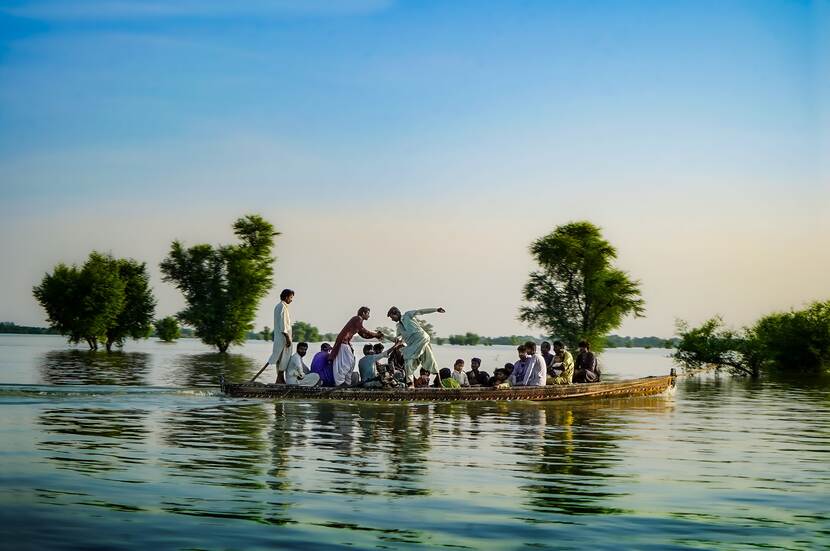The team left for Pakistan in November to evaluate the floods. ‘It was a perfect storm,’ explains team leader Jos de Sonneville. ‘The combination of heavy monsoon rains and melting water from the Himalayas caused extreme flooding in the river delta and on land.’
As a civil engineer, Jos has been working in water management for years. After completing his studies in Delft he lived abroad for 20 years, where he saw the impact of flooding for himself. This made a big impression on him. ‘In 1984 Cyclone Domoina caused major flooding in Mozambique. We went round in rubber boats saving people from the treetops.’ Pakistan is one of the 10 countries worst affected by climate change. The future water challenges the country faces will only be more acute. ‘Climate change means that the weather is going to get more extreme globally: too wet or, conversely, too dry,’ Jos explains. ‘Good water management, water security and administrative cooperation are, and will continue to be, vital. Not only in Pakistan, but also in the Netherlands.’
The Dutch Risk Reduction Team (DRR Team)The DRR Team advises governments on resolving urgent water issues including flooding, water pollution and drought; preventing water-related disasters; and overseeing reconstruction in the wake of a disaster. Countries can request assistance through the local Dutch embassy. The DRR Team will then select a suitable team leader and put together a team from the pool of available water experts, based on the expertise and experience the situation requires. |
Great initiative
Flooding doesn’t only damage buildings and infrastructure. It causes other long-term problems too. ‘Water can only escape through evaporation,’ Jos explains. ‘This water stays stagnant for months. Farmers can’t sow seeds, trucks can’t transport goods and diseases like malaria and dengue fever, which are transmitted via water, spread more easily.’ Jos has participated in a number of missions since the DRR Team was set up. ‘It’s a great initiative, sharing Dutch knowledge with other countries to help improve water management worldwide. For me personally it’s a really important thing to be involved with. Particularly once you’ve seen for yourself what other countries are up against.’
Nowhere to go
The team’s main recommendations were set out in a report submitted to the Pakistani authorities. In May 2023 a second mission will travel to Pakistan to discuss concrete follow-up steps with the local authorities and with international financial institutions including the Asian Development Bank. Jos believes that mitigation is the key in Pakistan. ‘Enormous population growth is putting food supplies, living space and the economy under pressure. Space is at a premium, and this in turn puts pressure on space for water.’
Adaptation and mitigation
In many cases there’s no lack of technical expertise. In Jos’ experience, a lack of cooperation between the different stakeholders is more often the problem. ‘Effective water management is not just about technical solutions. It requires a joint approach. For example, the organisations responsible for building homes need to draw up a joint plan with the parties responsible for planning irrigation, roads, railways, dikes and dams.’ The Netherlands has been battling water for centuries. And we want to share our expertise with countries worldwide. One of those countries is Pakistan, which in 2022 faced the most severe flooding in its history. Civil engineer Jos de Sonneville led a team of water experts sent to the disaster zone.
Space for the rivers
It’s not just a question of investing in higher dikes and stronger dams. In the end, there’ll always be a wave that’s higher. News item | 30-03-2023 | 10:44
Cooperation
Flooding will feature as a theme during the UN Water Conference in New York. The aim of the conference – the first UN Water Conference in almost 50 years – is to put issues associated with water higher on the agenda, worldwide. Read more about the conference’s main themes here. Based on their findings and discussions with local stakeholders, the DDR Team issues an advisory report that includes advice on how to better prepare the country for future flooding. ‘For example, building stronger dams and dikes, taking a different approach to flooding (adaptation) or by altering spatial planning in the areas affected (mitigation).’
Recommendations
In summer 2022 Pakistan was hit by extreme rainfall. Villages and infrastructure were washed away, more than 2 million people lost their homes, more than 1,700 people were killed and millions of animals drowned. At the request of Pakistan’s government, the Netherlands sent water experts from the Dutch Risk Reduction Team to help assess the situation.
UN Water Conference
While the worst of the flooding had subsided by the time Jos and his team arrived in Pakistan, a significant part of the country was still under water. ‘There was nowhere for the water to go,’ Jos explains. ‘The delta has become so built up – with roads, railways, irrigation channels, towns and villages – that the water can’t drain away. This causes the water level in the rivers to rise too. The water that used to take 3 weeks to flow from the top of the Himalayas to the ocean now takes much longer to get there, meaning there’s more water to deal with.’

